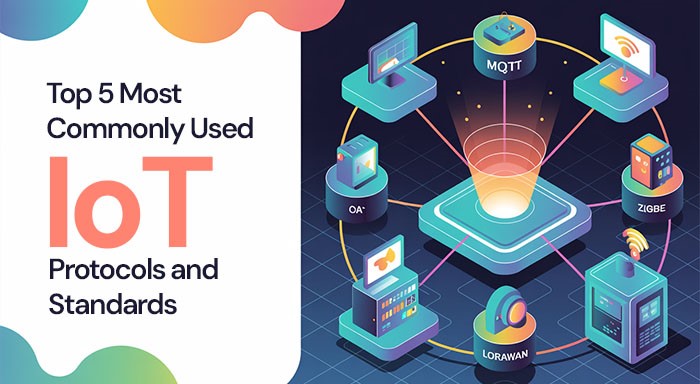
Introduction
The Internet of Things (IoT) has revolutionized the way devices communicate and interact, enabling seamless connectivity across billions of sensors, devices, and systems. At the heart of this transformation lie communication protocols and standards — the rules and frameworks that allow devices to exchange data efficiently, securely, and reliably.
In this blog, we’ll dive into the top 5 most commonly used IoT protocols and standards, explaining their roles, use cases, and why they matter in building scalable, efficient IoT solutions.
1. XMPP (Extensible Messaging and Presence Protocol)
The XMPP Protocol in IoT, originally developed for real-time messaging and presence detection in instant messaging platforms, has emerged as a valuable tool for IoT applications. Its strength lies in its decentralized architecture, extensibility, and strong support for real-time communication.
Why It’s Used in IoT:
- Enables secure, real-time messaging between devices.
- Supports asynchronous communication, ideal for loosely coupled systems.
- Open standard with strong community and vendor support.
Use Cases:
- Smart homes and building automation.
- Device-to-device communication in consumer IoT applications.
2. IoT Communication Protocols (Overview)
When we talk about IoT communication protocols, we’re referring to the broader ecosystem of transport, network, and application-layer protocols that facilitate device interaction. These include both wired and wireless protocols such as:
- MQTT (Message Queuing Telemetry Transport)
- HTTP/HTTPS
- Bluetooth, Zigbee, LoRaWAN
- 6LoWPAN
- Wi-Fi and Ethernet
Why They’re Essential:
- Enable connectivity across varied hardware and software platforms.
- Each protocol is suited to specific environments (e.g., low power, long-range, real-time).
- They form the backbone of data collection, transmission, and device control.
Use Cases:
- Everything from smart agriculture to industrial automation depends on choosing the right communication protocol stack.
3. AMQP (Advanced Message Queuing Protocol)
AMQP is a robust, open standard designed for message-oriented middleware, ensuring reliable message delivery and interoperability between systems.
Why It’s Used in IoT:
- Guarantees delivery even in unreliable network conditions.
- Offers rich message queuing, routing, and security capabilities.
- Supports interoperability across vendors and systems.
Use Cases:
- Financial services IoT applications.
- Backend enterprise systems integrating with IoT gateways and devices.
4. DDS (Data Distribution Service)
The DDS Protocol in IoT is designed for real-time, peer-to-peer communication using a publish-subscribe model. It stands out for its high-performance, scalability, and reliable messaging, making it a strong fit for mission-critical and time-sensitive IoT systems.
Why It’s Used in IoT:
- Designed for time-sensitive and mission-critical systems.
- Offers Quality of Service (QoS) policies to control latency, reliability, and bandwidth.
- Suitable for decentralized and distributed networks.
Use Cases:
- Industrial IoT, robotics, autonomous vehicles, and defense systems.
- Real-time health monitoring and control systems.
5. CoAP (Constrained Application Protocol)
CoAP is a lightweight protocol designed for constrained devices and networks. It follows a RESTful model like HTTP but is optimized for low power and limited bandwidth environments.
Why It’s Used in IoT:
- Minimal overhead, making it ideal for low-power devices.
- Works over UDP, reducing latency.
- Easy to map to HTTP for interoperability with the web.
Use Cases:
- Smart sensors in agriculture and environmental monitoring.
- Wearable and low-power home automation systems.
Final Thoughts
The choice of an IoT protocol depends heavily on the application requirements — whether it’s real-time performance, low power consumption, scalability, or interoperability. Understanding the strengths and trade-offs of each protocol allows developers and organizations to make informed decisions when architecting their IoT solutions.
As the IoT ecosystem continues to expand, these protocols will remain fundamental to creating secure, efficient, and intelligent connected systems.
Related Posts:
DDS and MQTT: Fundamentals, Challenges, and Integration Advantages
Components of IoT and Their Integration with Cloud Computing